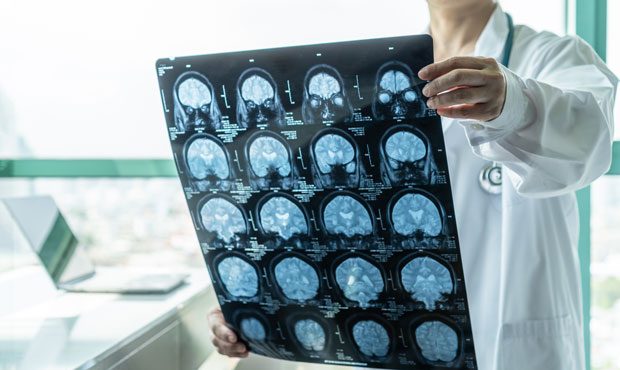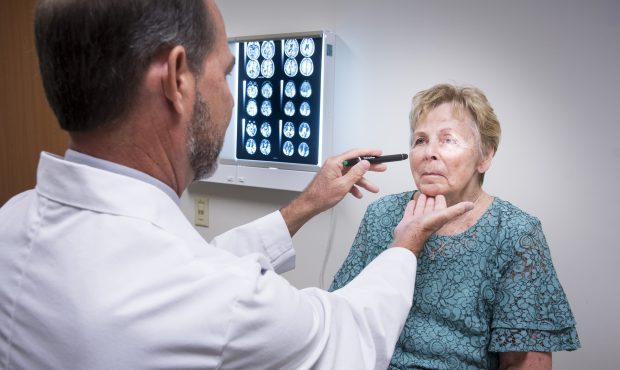More stroke patients eligible for acute treatment, thanks to research
Jul 27, 2021, 1:25 PM | Updated: Jul 29, 2021, 8:04 am

Historically, patients underwent acute stroke treatments according to strict time guidelines. But thanks to recent advancements in stroke research, more patients are becoming candidates for clot-busting drugs and endovascular therapy at specialized centers like Barrow Neurological Institute.
“If patients didn’t fit within a constrained time window, then they were automatically excluded from consideration for intervention,” said Michael Waters, MD, PhD, director of the Petznick Stroke Center at Barrow in Phoenix. “The direction we’ve been heading in the last five years, however, has been looking at brain physiology rather than simply time windows.”
Studies have shown that when someone experiences a stroke caused by a blockage in a blood vessel, known as an ischemic stroke, there is always an “ischemic core.” This describes the area of brain tissue that has died from inadequate blood supply and cannot be revived.
Surrounding the core, however, is the penumbra—an area of “stunned” tissue. That’s the part of the brain that stroke experts have a chance to save.
Imaging Advancements: An Individualized Approach to Stroke Treatment
In the past, brain imaging wasn’t sensitive or specific enough to differentiate between the core and the penumbra, and it certainly wasn’t sophisticated enough for stroke experts to apply any sort of grading system, Dr. Waters said.
Instead, experts generated time guidelines by looking at patient outcomes in large databases. They plotted these outcomes on curves according to how much time had elapsed between symptom onset and treatment.
With recent imaging innovations, however, stroke teams can now evaluate patients on a more individualized basis to see whether any of the affected brain tissue can be preserved.
“We can customize our treatment decisions for each patient as a unique person, which of course everybody is, rather than lump them into general categories,” Dr. Waters explained.
Barrow, an early adopter of this new imaging technology, utilizes it to vet patients for endovascular treatment for up to 24 hours after symptom onset.
Endovascular therapy for an ischemic stroke, also known as thrombectomy, involves passing a small catheter through an artery in the groin or wrist and navigating it through the system of blood vessels to the site of the blockage. Once there, the neurosurgeon can use specialized devices to break up or remove the clot.
“The results of five randomized, prospective trials published in the New England Journal of Medicine in 2015 clearly established endovascular treatment as the gold standard for the management of patients suffering from the worst kind of stroke,” said Felipe Albuquerque, MD, the director of endovascular neurosurgery at Barrow.
He added that the last six years have produced tremendous advances in endovascular techniques, including revolutionary refinements in the devices used to remove blood clots from the largest arteries in the brain.
As a Joint Commission-certified Comprehensive Stroke Center, Barrow has 24/7 access to advanced imaging, along with vascular neurologists and endovascular neurosurgeons. This enables Barrow to perform thrombectomy procedures around the clock.
“More patients are surviving and thriving in their lives because of this treatment,” Dr. Albuquerque said. “What a thrill and honor for me to work in our Comprehensive Stroke Center, where we have the tremendous privilege of saving lives every day.”

Barrow Neurological Institute
The Past and Future of Clot-Busting Drugs
The Barrow stroke team is also using advanced imaging to capture more patients who might be eligible for tissue plasminogen activator (tPA), or alteplase.
In 1996, the United States Food and Drug Administration (FDA) approved the clot-busting drug for up to three hours past symptom onset.
“This eliminates a lot of patients from consideration because as many as 20 to 30 percent of our stroke patients wake up with their symptoms,” Dr. Waters explained.
In 2009, clinical trial data prompted the American Stroke Association to recommend extending the tPA window to 4.5 hours—a guideline which Barrow adopted.
But because patients with wake-up strokes don’t know exactly when their symptoms started, they automatically receive an MRI scan at Barrow to determine if they’re a candidate for tPA. Emergency departments without immediate access to magnetic resonance imaging (MRI) are unlikely to consider patients with wake-up strokes for alteplase treatment.
Barrow houses three MRI magnets next to the emergency room and employs a technique specifically designed to capture wake-up strokes. This method involves evaluating patient imaging in two specific sequences to determine if the penumbra has progressed to tissue death.
Alteplase itself is also evolving. Dr. Waters sees a modification of the drug, known as tenecteplase, as the future of clot-busting drug therapy.
Tenecteplase doesn’t require as high of a dose as alteplase, yet it has a much longer half-life—the amount of time it takes for a drug’s active substance in the body to reduce by half. This means tenecteplase can be given all at once as a simple injection rather than as a continuous infusion.
Studies have also shown that tenecteplase poses a lower risk of bleeding complications while being equally as effective as alteplase. Another advantage of tenecteplase is that it’s about 30 percent less expensive than its predecessor.
Dr. Waters and his colleagues at the Petznick Stroke Center are nationally recognized as thought leaders in the implementation of tenecteplase and are generating protocols for administering the drug at Barrow.
When a Stroke Happens, ‘BE FAST’
While scientists and clinicians have made great strides in acute stroke treatment and more exciting developments are underway, Dr. Waters still sees much room for improvement.
“There are still only two acute treatments: tPA and thrombectomy,” he said. “Two treatments in a condition that affects 800,000 people a year.”
And although time constraints for these treatments have become less rigid, Dr. Waters reminds everyone that it’s still crucial to BE FAST in the event of a stroke:
B – Balance problems
E – Eye/vision problems
F – Face drooping
A – Arm weakness
S – Speech problems
T – Time to call 911


